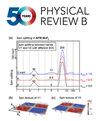外延 Co(101¯0) 薄膜中磁晶性和磁弹性各向异性的相互作用
IF 3.7
2区 物理与天体物理
Q1 Physics and Astronomy
引用次数: 0
摘要
为了创建面内(IP)单轴各向异性系统,我们通过磁控溅射沉积了一系列生长在带有 Ag(110) 和 Cr(211) 缓冲层的 Si(110) 基底上的外延 Co(101¯0) 薄膜。然而,利用铁磁共振测量对 IP 磁各向异性进行量化后发现,其行为比六方紧密堆积(hcp)Co 这样的简单单轴系统所预期的要复杂得多。即使厚度为 100 纳米,也能发现 Co 薄膜中的各向异性应变,主要存在于 Co 基面内,而 c 轴大部分不受影响。计算表明,这种未松弛应变会引起显著的磁弹性各向异性,与磁晶各向异性相抵消,从而降低了整体有效各向异性。详细的分析表明,沿 Co[101¯0] 面外方向的压缩应变是造成所观察到的磁弹性各向异性的主要原因,而沿 Co[1¯21¯0] IP 方向的拉伸应变只起次要作用。 美国物理学会发表于 2025 年本文章由计算机程序翻译,如有差异,请以英文原文为准。
Interplay of magnetocrystalline and magnetoelastic anisotropy in epitaxial Co(101¯0) films
With the goal of creating an in-plane (IP) uniaxial anisotropy system, we deposited a thickness series of epitaxial Co(101¯0) films grown on Si(110) substrates with Ag(110) and Cr(211) buffer layers by magnetron sputtering. However, quantifying the IP magnetic anisotropy using ferromagnetic resonance measurements revealed a much more complex behavior than expected for a simple uniaxial system like hexagonally close-packed (hcp) Co. To understand the experimental results, an in-depth x-ray diffraction analysis of the film structure was performed. Even at a thickness of 100 nm, it revealed an anisotropic strain in the Co films, mainly within the Co basal plane, while the c Co [ 10 1 ¯ 0 ] Co [ 1 ¯ 2 1 ¯ 0 ] Published by the American Physical Society 2025
求助全文
通过发布文献求助,成功后即可免费获取论文全文。
去求助
来源期刊

Physical Review B
物理-物理:凝聚态物理
CiteScore
6.70
自引率
32.40%
发文量
0
审稿时长
3.0 months
期刊介绍:
Physical Review B (PRB) is the world’s largest dedicated physics journal, publishing approximately 100 new, high-quality papers each week. The most highly cited journal in condensed matter physics, PRB provides outstanding depth and breadth of coverage, combined with unrivaled context and background for ongoing research by scientists worldwide.
PRB covers the full range of condensed matter, materials physics, and related subfields, including:
-Structure and phase transitions
-Ferroelectrics and multiferroics
-Disordered systems and alloys
-Magnetism
-Superconductivity
-Electronic structure, photonics, and metamaterials
-Semiconductors and mesoscopic systems
-Surfaces, nanoscience, and two-dimensional materials
-Topological states of matter
 求助内容:
求助内容: 应助结果提醒方式:
应助结果提醒方式:


